Xerxes I › Old Kingdom of Egypt » Ancient origins
Articles and Definitions › Contents
- Xerxes I › Who Was
- Old Kingdom of Egypt › Antique Origins
Ancient civilizations › Historical and archaeological sites
Xerxes I › Who Was
Definition and Origins

Xerxes I (ruled 486-465 BCE), also known as Xerxes the Great, was the king of the Persian Achaemenid Empire. His official title was Shahanshah which, though usually translated as `emperor', actually means `king of kings'. He is identified as the Ahasuerus of Persia in the biblical Book of Esther (although his son, Artaxerxes I, is also a possibility as is Artaxerxes II) and is referenced at length in the works of Herodotus, Diodorus Siculus, Quintus Curtius Rufus, and, to a lesser extent, in Plutarch. Herodotus is the primary source for the story of his expedition to Greece. The name ` Xerxes ' is the Greekversion of the Persian `Khshayarsa' (or Khashyar Shah), and so he is known in the west as `Xerxes' but in the east as `Khshayarsa'.
His mother was Atossa, the daughter of Cyrus the Great (who founded the Achaemenid Empire ). He was, therefore, accepted as a great king before having to prove himself so in any way. Xerxes is celebrated for his many building projects throughout his empire but is best known, in both ancient and modern sources, for the massive expedition he mounted against Greece in 480 BCE which, according to Herodotus, assembled the largest and most well equipped fighting force ever put into the field up to that point. He was the son of Darius the Great (550-486 BCE) who, in an effort to punish Athens for their support of the Ionian colonies' revolt against Persian rule, had invaded Greece in 492 BCE. The Persians were defeated by the Greek forces at the Battle of Marathon in 490 BCE, and Darius died in 486 BCE before he could mount another offensive. It, therefore, fell to his son to carry out his father's wishes and, in amassing an army of such size and strength, Xerxes felt confident of his success in achieving what the great Darius had been unable to realize.
XERXES HAD TO DEAL WITH THE INSURRECTION OF BABYLON & THE REVOLTS AGAINST PERSIAN RULE IN EGYPT.
EARLY CAMPAIGNS
Xerxes was not the eldest of Darius' sons but, as the first-born of his marriage with Atossa, was chosen as successor. Upon Darius' death, Xerxes' older half-brother, Artabazenes, claimed the throne but was rebuffed because his mother was a commoner while Xerxes' mother was the daughter of the great Cyrus. He married the princess Amestris, daughter of Otanes, who would become mother to his sons Darius, Hystaspes, Artaxerxes I, Achamenes, and daughters Amytis and Rhodogune.Upon assuming the throne, Xerxes' Commander-in-Chief of the Army, Mardonius (who was also his cousin and brother-in-law), pressured him to renew the campaign against Greece. Mardonius' motives, it seems, were personal, as he hoped to rule the conquered nation as Satrap following Xerxes' victory. Xerxes' uncle and advisor, Artabanus, tried to persuade him to abandon the expedition but Mardonius' arguments prevailed. Even so, there were many matters to attend to such as the insurrection of Babylon and the revolts against Persian rule in Egypt, and Xerxes expended considerable time throughout the year 485 BCE in quelling these and restoring order.
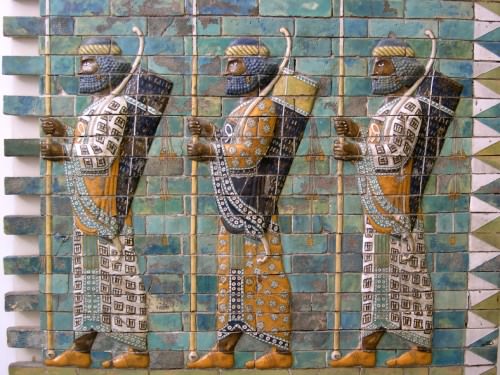
Persian Archers
Although his grandfather Cyrus had been a friend to Babylon, Xerxes had subjugated the city and melted down the golden statue of Marduk, their patron deity. This was a particular affront to the dignity and tradition of Babylon because one of the religious duties of a ruler was to grasp the hands of the statue of Marduk at the New Year's festival in order to ensure continued prosperity throughout the land; Babylon thus enjoyed a prestige among the cities of Mesopotamia as the site of this ritual. Cyrus had been diligent in officiating at the festival, as had Darius, but Xerxes considered it a matter of little consequence. He ignored the established relationships with former allies, referring to himself as the King of the Persians and the Medes, and treated all as subject to his rule. Babylon revolted against him twice before he lay siege to it and crushed the rebellion.
XERXES SPENT FOUR YEARS AMASSING ENOUGH SUPPLIES & WEAPONRY FOR HIS CAMPAIGN IN GREECE.
GREECE: THE PERSIAN WARS
With relative peace established in his empire, he again turned his attention to Greece and conquest. He spent four years amassing enough supplies and weaponry for the campaign and also conscripting as many men as he could from various regions to ensure his victory. Herodotus tells the story of Pythias the Lydian (a descendant of King Croesus ) whose five sons were among those conscripted. Pythias hosted the king and his army lavishly at Sardis in the winter of 481-480 BCE and offered to give Xerxes a considerable sum of money for the campaign, but Xerxes refused his offer and, instead, rewarded Pythias for his generosity by adding greatly to his treasury.
Prior to Xerxes' departure for the Hellespont, a bad omen in the form of an eclipse appeared in the sky but Xerxes, assured by his diviners that it meant nothing, proceeded with his plans. Pythias, however, recognized the omen as a warning of impending doom and, emboldened by Xerxes' generosity and kindness, asked if his eldest son could be released from the army so that he would have at least one son to care for him in his old age and carry on as heir. Xerxes became enraged at this request as it meant that Pythias doubted his chances of success. He had the eldest son removed from the ranks, cut him in half, placed the two sections of the corpse on either side of the road, and marched his troops away between them.
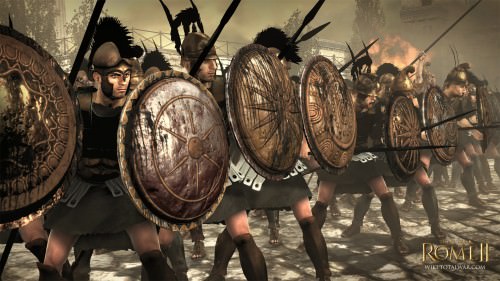
Greek Phalanx
According to Herodotus, the size of Xerxes' expeditionary force was over two million men and four thousand ships. Diodorus Siculus and Quintus Curtius Rufus confirm the enormity of Xerxes' army, though their numbers differ from Herodotus and from each other. In order to move his ships freely, he had a canal dug across the Isthmus of Actium near Mr. Athos, the remains of which are still visible in the present day. He assembled his forces to cross the Hellespont into Europe and, Herodotus reports, watched them as they stood in formation. The size of the army and its majesty
first gave Xerxes a feeling of deep self-satisfaction, but later he began to weep. When his uncle, Artabanus (the one who had at first freely expressed his opinion and advised Xerxes not to attack Greece) noticed that Xerxes was crying he said, `My lord, a short while ago you were feeling happy with your situation and now you are weeping. What a total change of mood!' `Yes,” Xerxes answered. `I was reflecting on things and it occurred to me how short the sum total of human life is, which made me feel compassion. Look at all these people – but not one of them will still be alive in a hundred years' time'(VII.45-46).
Even so, Xerxes put the thoughts of the brevity of life from his mind and ordered the crossing and the invasion of Greece.
The omens, from the start, were not favorable to Xerxes' cause. The Hellespont is said to have risen in revolt at his crossing.In order to move his massive force, Xerxes built bridges across the water. Herodotus writes:
The Phoenicians and the Egyptians who had been assigned the task set about building their bridges (the Phoenicians using white flax and the Egyptians papyrus), taking Abydus as their starting point and directing their efforts towards the headland on the opposite coast – a distance of seven stades. They had just finished bridging the straits when a violent storm erupted which completely smashed and destroyed everything. This news made Xerxes furious. He ordered his men to give the Hellespont three hundred lashes and to sink a pair of shackles into the sea. I once heard that they also dispatched men to brand the Hellespont as well. Be that as it may, he did tell the men he had thrashing the sea to revile it in terms you would never hear from a Greek. “Bitter water,” they said, this is your punishment for wronging your master when he did no wrong to you. King Xerxes will cross you, with or without your consent. People are right not to sacrifice to a muddy, brackish stream like you!” So the sea was punished at his orders and he had the supervisors of the bridging of the Hellespont beheaded. The men assigned this grotesque task carried out their orders and another team of engineers managed to bridge the Hellespont (VII.34-36).
ARTEMISIUM & THERMOPYLAE, FOUGHT MORE OR LESS CONCURRENTLY, PROVIDED THE PERSIANS WITH VICTORIES.
Once they had reached the other side, Herodotus writes, “a really extraordinary thing happened: a horse gave birth to a hare.Xerxes dismissed it as insignificant, though its meaning was transparent. It meant that, although Xerxes would walk tall and proud on his way to attack Greece, he would return to his starting-point running for his life” (VII.57). Besides the revolt of the waters of the Hellespont and the appearance of the hare, there were other omens which indicated that Xerxes' campaign would end badly, but Xerxes dismissed all of them as meaningless and proceeded on toward his goal.
The Greeks, in the meantime, had mobilized their forces under the direction of Athens and sent forces to meet the Persian expedition and defend the mainland. The battles of Artemisium and Thermopylae, fought more or less concurrently, provided the Persians with victories (either complete or strategic) which enabled them access to Greece, and they marched on Athens as soon as they were able. Xerxes was so enraged at the Athenian resistance to his wishes that he burned the city in a furious fit, which he so regretted that, later, he would reference this as his only remorse in the entire campaign.

Greek Trireme
THE BATTLE OF SALAMIS
At this point, the Greeks, who had abandoned Athens and most of the countryside, had gathered their forces off the coast of the mainland at Aegina and in the Peloponnese and their navy was anchored in the straits of Salamis. Xerxes called a warcouncil to decide on his next move and whether to engage the Greeks at Salamis, return home content with the destruction of Athens, or consider other alternatives. Mardonius counseled in favor of a sea battle, as did all the other allied leaders, except for Artemisia of Caria who provided Xerxes with other options. She claimed that he need do nothing to secure victory but keep the Greeks in place until their supplies ran out and they sued for peace. While he clearly respected Artemisia and thanked her for her advice, he chose the majority opinion and committed to the naval engagement.
The Battle of Salamis, which followed, was a disaster for the Persian fleet and cost Xerxes dearly. Following the loss, he again consulted Artemisia for advice and she told him he should return home and accept Mardonius' offer to remain behind and conquer the Greeks in Xerxes' name. This time he accepted her counsel and left the country with Mardonius remaining behind to continue the war effort. Mardonius was defeated the following year at the Battle of Plataea which was fought on the same day as the equally decisive Battle of Mycale, 27 August 479 BCE.
Mardonius was killed and, with his death, the Persian forces scattered and Xerxes' ambitions for subjugating Greece were crushed. As the omen had predicted, Xerxes returned home `limping' with a fraction of his army and was forced to eat bark, weeds, and leaves because there was no food left in the regions they traveled through. The men were ravaged by disease and many died of dysentery and so, by the time Xerxes crossed back across the Hellespont and reached Sardis, he had hardly any army left to speak of.
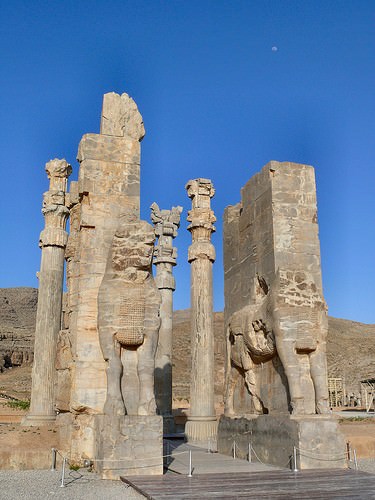
All Nations Gate at Persepolis
XERXES' BUILDING PROJECTS & DEATH
Back home, Xerxes concentrated his efforts on making larger and grander monuments and completing greater building projects than his father. In doing so, he depleted the royal treasury to an even greater extent than his expedition to Greece already had. He maintained the roadways throughout the empire, especially the Royal Road by which messages were carried (the precursor to the Roman mail system and, later, the modern-day postal system) and devoted both time and funds to expanding sites such as Susa and Persepolis. Although Darius' palace still stood, Xerxes' commissioned an even more elaborate building project to raise his own opulent palace nearby and also commanded the construction of the Hall of a Hundred Columns and the building which has been designated `The Harem' by archaeologists (because of the duplication of identical rooms in a row) which may have actually served as Xerxes' treasury. The exorbitant cost of these projects, coupled with the expense of the expedition to Greece, put a tremendous strain on Xerxes' subjects through heavy taxation. Xerxes, however, appeared not to notice a problem and continued to do as he pleased; because of this, his rule marks the beginning of the decline of the Achaemenid Empire.
ACCORDING TO HERODOTUS, XERXES' FONDNESS FOR WOMEN & LACK OF RESTRAINT LED TO HIS PURSUIT OF HIS BROTHER MASISTES' WIFE.
According to Herodotus, Xerxes' fondness for women and lack of restraint led to his pursuit of his brother Masistes' wife. When she refused him, he married one of his sons, Darius, to the daughter of Masistes, Artaynte, in hopes that, by this union, he could get closer to his brother's wife and manage to seduce her. When he saw Artaynte, however, he desired her more than the mother and, when he approached her, she agreed to an affair. Herodotus reports that, at about this same time, Xerxes' wife Amestris had woven him a beautiful shawl, which he liked so much he wore everywhere. Artaynte admired the shawl and, one day when Xerxes told her that he would give her any gift she asked for, she requested the shawl. He tried to get her to take any other gift instead because he knew that, should he give his mistress the shawl, his wife would discover the affair. He had given his word, however, and Artaynte refused any other gift, and so he gave her the shawl.
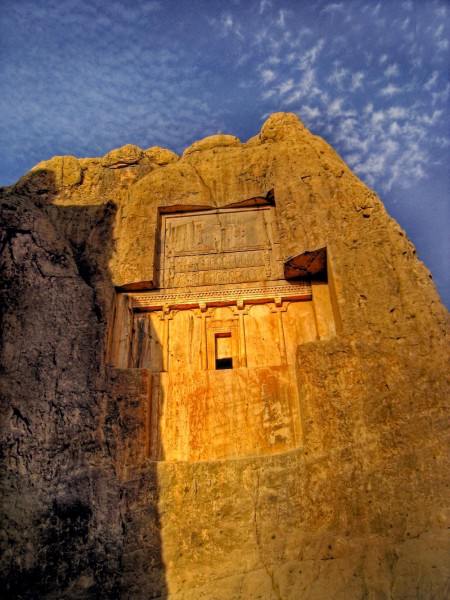
Tomb of Xerxes
As he feared, Amestris heard that Xerxes' mistress was wearing the shawl and plotted revenge. She decided to focus her energies, not on the mistress, but on Artaynte' s mother who she blamed for not raising a proper daughter (and, perhaps, because she had guessed that Artaynte was Xerxes' second choice in a mistress). At the royal banquet known as Tukta, which was held once a year and at which the king granted gifts to his subjects, Amestris asked for Masistes' wife to be delivered to her. As with Artaynte and the shawl, Xerxes pleaded with Amestris to make any other request, but she would not do so.
Xerxes then gave his brother's wife to Amestris who, according to Herodotus, “sent for Xerxes' personal guards and with their help mutilated Masistes' wife. She cut off her breasts and threw them to the dogs, cut off her nose, ears, lips, and tongue, and then sent her back home totally disfigured” (9:112). In response, Masistes tried to raise a revolt in Bactra but Xerxes, hearing of his plans, trapped him and killed him, his sons, and all of the men he had rallied to his cause. Xerxes then returned to his building projects and designs for greater, grander, monuments to commemorate his reign and distinguish him from his father.His development plans were cut short through his assassination by his minister Artabanus (a different man than his uncle of the same name) who also murdered his son Darius. Xerxes' other son, Artaxerxes I, then killed Artabanus, took the throne, and went on to complete Xerxes' grand building plans in his own name and for his own greater glory.
Old Kingdom of Egypt › Antique Origins
Definition and Origins
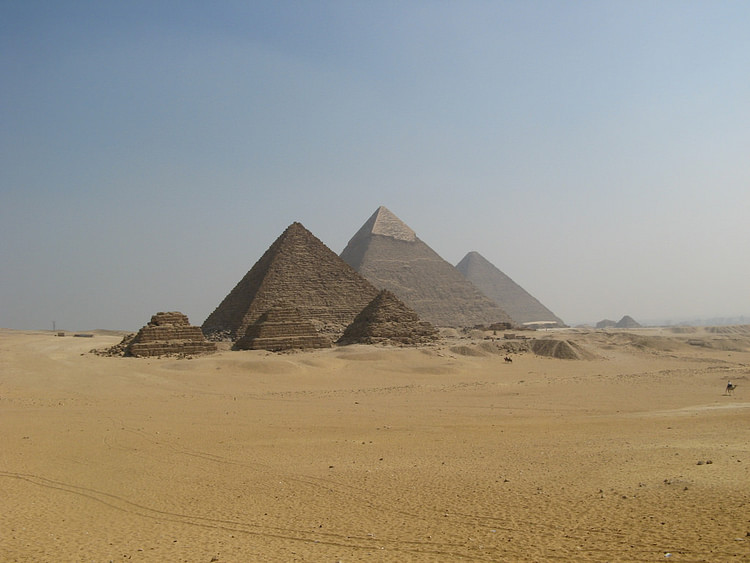
The Old Kingdom of Egypt (c. 2613-2181 BCE) is also known as the 'Age of the Pyramids ' or 'Age of the Pyramid Builders' as it includes the great 4th Dynasty when King Sneferu perfected the art of pyramid building and the pyramids of Giza were constructed under the kings Khufu, Khafre, and Menkaure. The historical records of this period, the 4th-6th Dynasties of Egypt, are scarce and historians regard the history of the era as literally 'written in stone' and largely architectural in that it is through the monuments and their inscriptions that scholars have been able to construct a history. The pyramids themselves relay scant information on their builders, but the mortuary temples built nearby and the stelae which accompanied them provide king's names and other important information. Further, inscriptions in stone found elsewhere from the time record various events and the dates on which they occurred. Finally, the tomb of the last king of the 5th Dynasty, Unas, provides the first Pyramid Texts (elaborate paintings and inscriptions inside the tomb) which shed light on the religious beliefs of the time.
The pyramids, though, are primarily what the Old Kingdom is most famous for. Historian Marc van de Mieroop writes how the Old Kingdom is "possibly unparalleled in world history for the amount of construction they undertook" (52). The pyramids at Giza, and elsewhere, during this period required unprecedented bureaucratic efficiency to organize the labor force which built the pyramids, and this bureaucracy could only have functioned under a strong central government. Van de Mieroop continues:
Most of the 20-some kings compelled thousands of laborers to quarry, transport, put in place, and decorate vast quantities of stone in order to construct royal mortuary monumnets. They diverted enormous resources from the entire country for this purpose, filling a 70-kilometer-long stretch of the desert edge along the west bank of the Nile near modern Cairo with huge monuments still awe-inspiring today despite the ravages of time (52).
The 4th Dynasty of the Old Kingdom was a time of progress and a strong centralized government which could command the kind of respect necessary for such building projects. During the 5th and 6th Dynasty, however, the priesthood began to grow in power, primarily through their hold over the very mortuary practices which gave rise to the great pyramids, empowering the local officials of the districts and the kingship suffered. The Old Kingdom began to collapse as more and more local governors assumed more power over their regions, and the central government at Memphis was increasingly seen as irrelevant.
THE 4TH DYNASTY OF THE OLD KINGDOM WAS A TIME OF PROGRESS & A STRONG CENTRALIZED GOVERNMENT WHICH COULD COMMAND THE KIND OF RESPECT NECESSARY FOR HUGE BUILDING PROJECTS.
At the end of the 6th Dynasty, there was no longer a central government of note and Egypt entered a period of social unrest and reformation known as The First Intermediate Period (2181-2040 BCE) during which Egypt was ruled regionally by local magistrates who made and enforced their own laws. The rise of these local officials and the power of the priesthood were not the only causes of the collapse of the Old Kingdom, however, in that a severe drought toward the end of the 6th Dynasty brought famine which the government could do nothing to alleviate. Scholars have also pointed to the exceptionally long reign of Pepi II of the 6th Dynasty as a contributing factor because he outlived his successors and left no heir to the throne.
Many scholars today no longer see the end of the Old Kingdom as a 'collapse' so much as a transition to the new paradigm of the First Intermediate Period, when local rulers governed their districts directly and the kind of wealth previously only available to nobility became more widespread. The long-standing designation of a political and cultural collapse at the end of the 6th Dynasty is still considered viable, however, in that the central government's loss of power and wealth led directly to the regional rule of the district nomarchs.
THE THIRD DYNASTY & THE OLD KINGDOM
The name 'Old Kingdom' was coined by archaeologists in the 19th century CE in an attempt to demarcate Egypt's long history.The Egyptians themselves did not refer to this period by that name and would have seen no difference between the period which preceded or succeeded it. Scholars traditionally included the Third Dynasty of Egypt (c. 2670-2613 BCE) in the period of the Old Kingdom because of the Pyramid of King Djoser at Saqqara, the first pyramid ever built in Egypt, seemed to link that dynasty to the building efforts of the 4th Dynasty, because the last king of the Third Dynasty was related to the first king of the 4th, and because Djoser and his successors ruled from Memphis ("the white walls") which remained the capital during the Old Kingdom. Recent scholarship, however, rejects that view as the construction of Djoser's pyramid is more in keeping with the Early Dynastic Period in Egypt (c. 3150-2613 BCE) than the Old Kingdom as are cultural practices and observances.
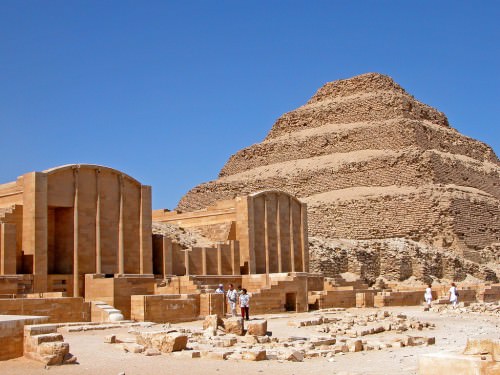
Step Pyramid Complex at Saqqara
Djoser's architect Imhotep (c. 2667-2600 BCE) revolutionized construction in Egypt by building the king's tomb at Saqqara out of stone. Prior to Imhotep's innovation, tombs and other structures were built of mud brick. The early tombs of Egypt were mud brick mastabas, but Imhotep wanted a lasting memorial to his king and so created a complex with a stone pyramid as its center and surrounding temples; thus inventing the paradigm which would be followed by every dynasty which followed to greater or lesser degrees. Further, it was during the Third Dynasty that the independent states of the country came to be known as nomes (districts) directly under the rule of a centralized government at Memphis. These developments in architecture, politics, and also in religious practices - all a departure from the past - made it clear to Egyptologists that the Third Dynasty was the beginning of a new period in Egypt's history and should be included in the Old Kingdom rather than the Early Dynastic Period.
Today, however, scholars see the Third Dynasty as a transitional phase more closely linked to the earlier period than the latter.Even though Djoser's pyramid of stone was a wholly new creation it still utilized Early Dynastic Period techniques. The pyramid at Saqqara is actually a stack of mastabas rather than a true pyramid and, regarding the political reforms and creation of nomes, the central government of the Third Dynasty did not have the reach nor command the resources of the 4th Dynasty.For these reasons and others, the Old Kingdom is now thought to begin with the 4th Dynasty of Egypt, although, it should be noted, this claim is not at all universally accepted among scholars.
THE FIRST TRUE PYRAMID
The last king of the Third Dynasty, Huni (c. 2630-2613 BCE), was long thought to have initiated the massive building projects of the Old Kingdom in constructing the pyramid at Meidum, but credit for the Meidum pyramid goes to the first king of the 4th Dynasty, Sneferu (c. 2613-2589 BCE) who may have been Huni's son by one of his minor queens. Egyptologist Barbara Watterson writes, "Sneferu initiated the golden age of the Old Kingdom, his most notable achievements being the two pyramids built for him at Dahshur" (50-51). Sneferu began his work with the pyramid at Meidum now referred to as the "collapsed pyramid" or, locally, as the "false pyramid" because of its shape: it resembles a tower more than a pyramid and its outer casing rests around it in a gigantic heap of gravel.
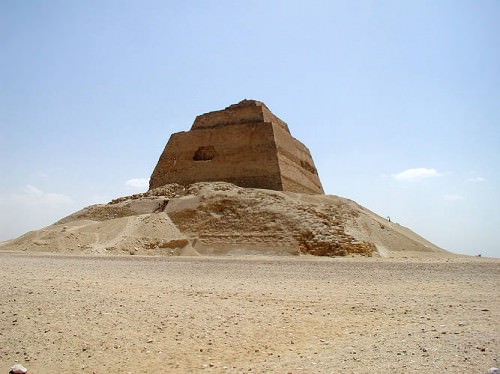
Meidum Pyramid
The pyramid of Meidum is the first true pyramid constructed in Egypt but did not last. This is because modifications were made to Imhotep's original pyramid design which resulted in the outer casing resting on a sand foundation rather than rock, causing it to collapse. Scholars are divided on whether the collapse occurred during construction or over a longer period of time.Egyptologist Miroslav Verner cites the work of the archaeologist Borchardt in claiming that the pyramid was built in stages, which increasingly had the outer foundation resting on sand while the inner foundation was securely built on rock. When the workers reached the third stage of the building process, the outer casing, the structure lacked cohesion because it had no firm footing "with the result that during the final phase of construction a massive slippage buried the workers under the rubble" (162). Other scholars, however, disagree and claim that the outer casing lasted into the New Kingdom of Egypt (1570-1069 BCE). Still others, like historian Marc van de Mieroop, claim that it is impossible to tell when the outer casing collapsed.
Unfinished temples and other structures have been found at Meidum which suggest that the pyramid complex was never finished and so argue for an early collapse of the pyramid, most likely while it was still under construction. Sneferu learned from his mistake, however, and moved on to his next two pyramids at Dahshur.
KING SNEFERU & HIS PYRAMIDS
Sneferu's pyramids at Dahshur are known as the Bent Pyramid and the Red Pyramid (or North Pyramid). The Bent Pyramid is so called because it rises at a 55-dgree angle and then shifts to 43 degrees of smaller stones giving it the appearance of bending in toward the top. The workers had completed the foundation and the sides before realizing that a 55-degree angle was too steep and modified their plan to finish the project as best they could. Sneferu seems to have understood the problem and moved on to build his third pyramid.
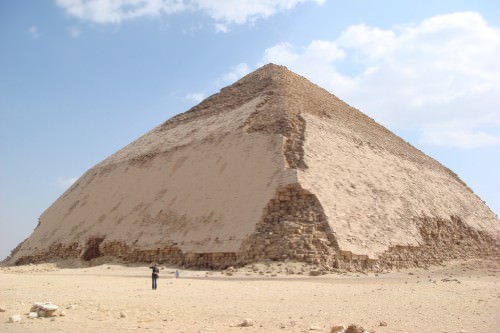
Bent Pyramid
According to inscriptions on the Palermo Stone, Sneferu was a much-admired king, who commanded great respect from his people. Barbara Watterson, commenting on the Palermo Stone inscriptions, writes:
He led military expeditions to Sinai to protect Egypt's interests in the turquoise mines, and to northern Nubia and Libya, bringing back from Nubia 7,000 prisoners and 200,000 head of cattle and, from Libya, 11,000 prisoners and 13,100 head of cattle. The prisoners were probably used to augment the work-force in quarries. In succeeding generations, Sneferu acquired the reputation of being beneficent and liberal and, according to a story recounted in the Westcar Papyrus, capable of the common touch in addressing one of his subjects as 'my brother.' (51)
Sneferu seems to have been a very accessible ruler who was undeterred by failure or disappointment. When the Bent Pyramid did not meet his expectations he simply started on a third attempt. The Red Pyramid (so called because of the use of reddish limestone in construction) was built on a solid base for greater stability, rising at a 43-degree angle. 344 feet (105 meters) high, the Red Pyramid was the first successful true pyramid built in Egypt. Originally it was encased in white limestone, as the other later pyramids were also, which fell away over the centuries and were harvested by locals for other building projects.
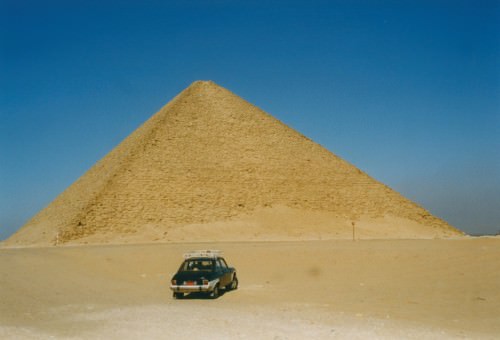
Red Pyramid
King Sneferu, through his military expeditions and judicious use of resources, established a powerful central government at Memphis which produced the kind of stability necessary for his vast building projects. Following the example of Djoser's complex at Saqqara, Sneferu had mortuary temples and other buildings constructed around his pyramids with priests taking care of the day-to-day operations once the Red Pyramid was finally completed. All of this argues for a stable society under his reign which he left to his son, Khufu, when he died.
KHUFU & THE GREAT PYRAMID
Khufu (2589-2566 BCE) was known as Cheops by the ancient Greek writers and is best known for his Great Pyramid at Giza.The Greeks depicted him as a tyrant in their writings who oppressed the people and forced them to work for him against their will. This impression may have been made by the stories which make up the document known as the Westcar Papyrus, a collection of four stories written about the kings of the 4th Dynasty and discovered (or obtained from an antiquities dealer) in c.1824 CE by Henry Westcar. The papyrus features four stories told by sons of Khufu and includes one where King Khufu calls a magician to court who claims to be able to reattach a severed head to a body, and some scholars have interpreted his actions in asking for a demonstration as cruel or thoughtless. According to Barbara Watterson, "the Westcar Papyrus portrays him as careless with life" and other inscriptions show him as "oppressive and autocratic" (51). In the story of the magician and the severed head, however, Khufu seems mostly skeptical of the seer's abilities, and the other stories, though related by Khufu's sons or successors, have to do with other kings. The Westcar Papyrus gives no indication that Khufu was a tyrant or oppressive in any way.
Most likely, the ancient Greeks who wrote of "Cheops" as a tyrant took their lead from Herodotus, who writes that Khufu brought to Egypt "every kind of evil" for his own glory, forcing "a hundred thousand men at a time, for three months continually" to work on his pyramid (II.124). Further, Herodotus claims, Khufu was so in need of money that he sent his daughter to work in the brothels of Memphis and demand a high price for her services (II. 124). His claims have been discredited through Egyptian texts, which praise Khufu's reign, and physical evidence, which suggests the workers on the Great Pyramid were well cared for and performed their duties as part of a community service, as paid laborers, or during the time the Nile's flood made farming impossible. Scholars Bob Brier and Hoyt Hobbs note:
Were it not for the two months every year when the Nile's water covered Egypt's farmland, idling virtually the entire workforce, none of this construction would have been possible. During such times, a pharaoh offered food for work and the promise of a favored treatment in the afterworld where he would rule just as he did in this world.For two months annually, workmen gathered by the tens of thousands from all over the country to transport the blocks a permanent crew had quarried during the rest of the year. Overseers organized the men into teams to transport the stones on sleds, devices better suited than wheeled vehicles to moving weighty objects over shifting sand. A causeway, lubricated by water, smoothed the uphill pull. No mortar was used to hold the blocks in place, only a fit so exact that these towering structures have survived for 4,000 years - the only Wonders of the Ancient World still standing today. (17-18)
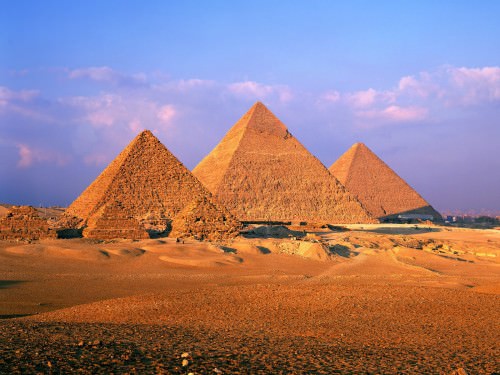
The Pyramids of Giza
The Great Pyramid, actually, is the only one of the structures at Giza which was considered one of the ancient Seven Wonders of the World and with good reason: until the Eifel Tower was completed in 1889 CE, the Great Pyramid was the tallest structure on earth built by human hands. Historian Marc van de Mieroop writes:
The size boggles the mind: it was 146 meters high (479 feet) by 230 meters at the base (754 feet). We estimate that it contained 2,300,000 blocks of stone with an average weight of 2 and 3/4 tons some weighing up to 16 tons. Khufu ruled 23 years according to the Turin Royal Canon, which would mean that throughout his reign annually 100,000 blocks - daily about 285 blocks or one every two minutes of daylight - had to be quarried, transported, dressed, and put in place...The construction was almost faultless in design. The sides were oriented exactly toward the cardinal points and were at precise 90-degree angles. (58)
However Herodotus and the later Greeks viewed Khufu, his people admired him. During his reign, Egypt grew even more wealthy through his military campaigns against Nubia and Libya and his very prosperous trade agreements with cities such as Byblos. He also devoted resources to improving the lives of his subjects through agricultural innovations. Miroslav Verner writes, "during his reign the earliest known dam in the world was built in Wadi Gerawi, in the mountains west of modern Helwan" (155). This dam aided the farmers and others in the community by improving the water supply.
Although Memphis remained the capital of Egypt during Khufu's reign, he most likely lived in a palace at Giza to oversee the work on the Great Pyramid himself. In order to maintain maximum efficiency in government and waste as little time as possible, he gave the greatest amount of power to his most trusted family members, who must have been pleased with the arrangement as there is no record of internal strife during his rule.
KHAFRE, THE SPHINX, & MENKAURE
After Khufu's death, he was succeeded by a family member outside the legitimate line named Djedefre (2566-2558 BCE).Verner notes that early Egyptologists considered the destruction of this king's pyramid complex in Abu Rawash to be evidence of internal family strife but, actually, the "intensive devastation began in Roman times, when the monument degenerated into a stone quarry" and the Romans used the stone for other building projects (156). Djedefre was certainly Khufu's son, but it seems he was not his chosen successor. Theories regarding family conspiracies against him, however, appear unfounded.
The most important aspect of Djedefre's reign, however, is not his pyramid or the claim that he built the Sphinx but his association of the position of king with the cult of the sun god Ra. He was the first king of Egypt to apply the title "Son of Ra" to himself marking the kingship as subordinate to the sun god. In the Second Dynasty, king Raneb had linked his name to the gods and so established the king as the gods' representative on earth, the living embodiment of the gods. After Djedefre's reform, the king would still be seen as a divine representative but now in a more subordinate position as a child of god.
Djedefre is considered by some scholars (such as Dobrev in 2004 CE) the creator of the Great Sphinx of Giza while others attribute this monument to his brother, and successor, Khafre (2558-2532 BCE). The Sphinx is the largest monolithic statue in the world depicting a reclining lion's body with the head and face of a king. Traditionally this king's face is accepted as Khafre, but Dobrev and others claim it may actually be Khufu's. It seems likely that it was created by Khafre since it is perfectly in line with his pyramid complex and the Sphinx's face seems to resemble Khafre's more than Khufu's. Brier and Hobbs write:
Khafre's pyramid rises even higher than its famous neighbor, although it actually stood ten feet shorter when it was new. Its gleaming casing of white limestone, transported by boats from quarries across the Nile, still covers the top, laid over interior limestone blocks which were cut from the surrounding Giza site. Probably in the course of freeing these interior blocks, quarrymen struck a seam of harder rock they avoided, leaving a small hill. Khafre had this outcrop carved in the shape of a recumbent lion bearing his own face - the famous Sphinx. (16)
The pyramid of Khafre is the second-largest at Giza and his complex almost as grand as his father's. Little is known of his reign but the Greeks (who called him Chephren) viewed him just as they had his father: as a tyrant who oppressed his people in the interests of building his grand mortuary monument. Egyptian texts indicate he followed his father's policies and model of government in placing power in the hands of his closest family members and maintaining a tight control over policies and laws.Khafre associated himself with the god Horus (as earlier kings had done), and the Sphinx was considered an image of the king as the god Harmakhet ('Horus in the Horizon'). Unlike the kings of the Early Dynastic Period, however, Khafre - and those who came after him - referred to himself as a "Son of Horus", associated with the god but not the living god himself. The power of interpreting the will of the gods, though still within the king's sphere of influence, grew increasingly the provenance of the priests who served those gods.
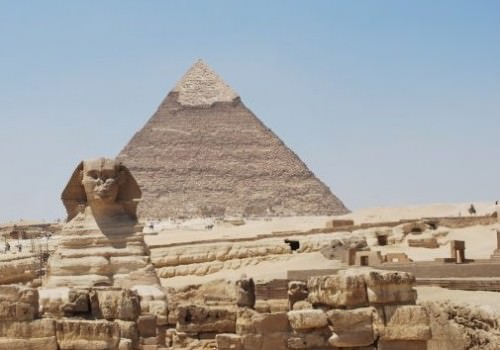
Sphinx and Khephren Pyramid
Following Khafre's death, succession was again interrupted briefly when Baka, son of Djedefre, took the throne. He did not even reign a year, however, before Menkaure (2532-2503 BCE), Khafre's son, became king. Menkaure (known as Mykerinos by the Greeks) is viewed favorably by both the Greeks and the Egyptian texts. Like his father and grandfather before him, Menkaure began building his pyramid and temple complex at Giza. Although today the Giza plateau is an ancient sand-swept site on the outskirts of Cairo, in the time of Menkaure it was a city of the dead inhabited by the living who cared for it. Priests' homes, temples, workmen's housing, shops, factories, breweries, and all the aspects of a small city were present at Giza.
Contrary to the popular belief that the pyramids of Giza were built by slave labor (specifically Hebrew slave labor), they were actually constructed by Egyptians, many of whom were highly skilled workers who were paid for their time. The pyramids are thought to represent the primordial mound, the ben-ben, which first rose from the waters of chaos at the beginning of creation.Although slave laborers from Nubia, Libya, even Canaan and Syria, were most likely used in the quarries cutting rock or in the gold mines, they would not have been entrusted to create the king's eternal home in the image of the first earth to rise from the waters. No slave quarters have been discovered at Giza and no Egyptian records relate any event such as that set down in the biblical Book of Exodus. Workmen's quarters, supervisor's houses, overseer's homes have all been found and make clear that the work done at the Giza plateau in the Old Kingdom was performed by Egyptians working for compensation.
Menkaure's pyramid and complex is smaller than the other two and this signifies an important development in the history of the Old Kingdom and one of the reasons why it would collapse. The resources necessary for the building of the Great Pyramid were no longer available in Menkaure's time but he still drew on what he could to create an eternal home on par with his father's and grand-father's. Menkaure's son and chosen successor, Khuenre, died while the pyramid was being built, which upset the dynastic succession, and Menkaure himself died before the pyramid complex was completed. Although he reigned for some thirty years, he was not able to complete what his predecessors had done, and to many scholars (Verner and Watterson among them) this signifies the dwindling resources at his command. His successor, Shepseskaf (2503-2498 BCE), completed Menkaure's complex at Giza but was himself buried in a fairly modest mastaba at Saqqara.
The kings, as previously noted, were diverting enormous resources to their mortuary monuments and complexes, but these temples and shrines were increasingly no longer under the king's control but that of the priests who administered them. After Shepseskaf's brief reign the 4th Dynasty came to an end and the 5th began with much less promise than when Sneferu had succeeded Huni.
THE 5TH & 6TH DYNASTIES & COLLAPSE
It was Sneferu who had first associated his dynasty with the solar cult of the god Ra, but it was Djedefre who reduced the status of the king from a living god to the son of that god. The priests grew in power at the expense of the throne but, still, the king was the representative of the gods on earth and commanded respect and power. Exactly how much respect and power was waning, however.
The 5th Dynasty is known as the dynasty of the Sun Kings because the names of so many have the god Ra's name in them (usually given as Re). The first three of these kings (Userkaf, Sahure, and Kakai) would later be honored as divinely appointed in the story The Birth of the Kings from the Westcar Papyrus. The dynasty begins with the king Userkaf (2498-2491 BCE), but a woman named Khenkaues, most probably a daughter of Menkaure, features largely in the inscriptions of the time as "Mother of Two Kings of Upper and Lower Egypt" though it is unknown who those kings were. Her tomb is the fourth pyramid at Giza, and she was obviously a very important figure, but little is known of her.
Userkaf is best known for the construction of the Temple of the Sun at Abusir. This building marks an important departure from the role of the king at the beginning of the 4th Dynasty and the beginning of the end of Giza as the necropolis of the kings. The sun god Ra was now worshiped directly by the people through the offices of the priesthood and the king's role as direct representative of the god was diminished. Barbara Watterson comments on this:
Na Quarta Dinastia, um dos componentes do titulary real, o nome nsw-bit (Rei do Alto e Baixo Egito) foi ocasionalmente escrito dentro de uma cartela, significando assim que o rei governava sobre tudo que o disco do sol, ou Ra, rodeava.. O uso da cartela tornou-se normal na Quinta Dinastia, quando os reis adotaram o título "Filho de Ra". Em dinastias anteriores, os reis eram considerados a manifestação terrena do deus Hórus; mas, acrescentando o novo título ao monarca real, eles reduziram seu status de deus para filho de deus. A autoridade divina do rei foi erodida ainda mais na Quinta Dinastia, quando os templos foram erigidos em locais de pirâmide não, como antes, para a adoração do rei, mas para a celebração do culto de Ra. (52)
Userkaf foi sucedido por seu filho Sahure (2490-2477 aC) que construiu seu complexo mortuário em Abusir, perto do Templo do Sol. Sahure era um governante eficiente, que organizou a primeira expedição egípcia à Terra do Punte negociou importantes acordos comerciais com outras nações. Punt estava entre suas maiores conquistas, no entanto, uma vez que se tornaria uma importante fonte de muitos dos recursos mais valorizados do Egito e, com o tempo, considerado como uma terra mítica dos deuses. Sahure construiu seu próprio Templo para o Sol em Abusir e foi o primeiro a fazer uso das colunas palmiformes na arquitetura que se tornaria padrão para colunas em todo o Egito a partir de então (as colunas conhecidas cujos topos têm a forma de folhas de palmeira). As expedições militares de Sahure e o uso prudente de recursos enriqueceram o país, como evidenciado pelo elaborado trabalho feito em seu complexo mortuário e inscrições encontradas.
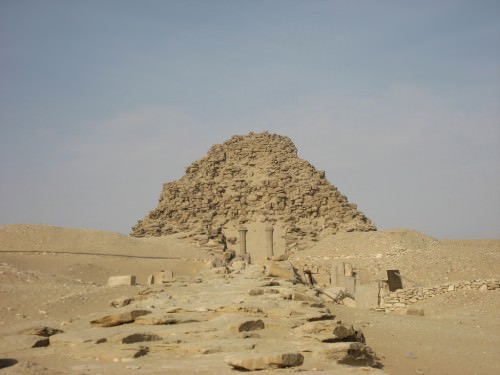
Pyramid of Sahure
Ele foi sucedido por seu filho Neferirkare Kakai (2477-2467 aC). Inscrições indicam que ele era um bom rei e muito respeitado, mas pouco se sabe de seu reinado, exceto que o sacerdócio cresceu ainda mais poderosamente durante seu governo. Seu filho, Neferefre (2460-2458 AC), o sucedeu, mas morreu pouco tempo em seu reinado, provavelmente por volta dos 20 anos. O rei Shepsekare o sucedeu, mas nada se sabe sobre seu reinado. Ele é sucedido por Nyussere Ini (2445-2422 aC), durante cujo reinado os sacerdotes de Ra ganharam ainda mais poder. A burocracia dos templos e dos complexos funerários também aumentou, o que aumentou as pressões sobre o tesouro real que pagava pela manutenção e manutenção do templo. O rei Menkauhor Kaiu (2422-2414 AEC) o sucedeu, mas muito pouco se sabe sobre seu reinado, exceto que ele foi o último rei a construir um templo para o sol.Ele foi sucedido por Djedkare Isesi (2414-2375 aC).
As origens de Djedkare Isesi são desconhecidas. Ele não é considerado o filho de Menkauhor Kaiu, mas poderia ter sido relacionado. Seu reinado é marcado pela extensa reforma da burocracia e do sacerdócio em um esforço para manter uma economia estável. Djedkare Isesi rejeitou a prática tradicional de construir um templo para o deus sol e reduziu o número de sacerdotes necessários para a manutenção dos complexos mortuários. Ele também organizou a segunda expedição a Punt, que enriqueceu o Egito e fortaleceu ainda mais os laços com Punt.
É possível que a partida de Djedkare Isesi do culto do deus sol tenha a ver com o desenvolvimento do culto a Osíris e sua ênfase na vida eterna através da associação com o deus que havia morrido e retornado à vida. Embora o culto de Osíris não se tornasse popular até o período do Império do Meio do Egito(2040-1782 aC), as evidências sugerem fortemente que essa antiga divindade agrícola já estava associada à morte e ressurreição durante o Antigo Império. O fato de o Djedkare Isesi ter sido venerado por seu próprio culto durante séculos após sua morte apoiaria essa afirmação. O culto de Osíris se tornou mais difundido e muito mais popular do que o culto de Rá e Djedkare Isesi, como um dos primeiros adeptos reais do culto, teria recebido grande respeito dos membros posteriores.
O aspecto mais significativo do reinado de Djedkare Isesi, no entanto, foi a descentralização do governo em Memphis, que colocou maior poder nas mãos das autoridades locais. Isso foi feito para diminuir os custos da burocracia maciça que havia crescido durante a quinta e a quinta dinastias. Embora a ideia pudesse ter feito sentido, essencialmente deu mais poder às regiões onde os padres locais já eram influentes o suficiente para ordenar os administradores governamentais e assim fizeram os esforços anteriores do rei em reduzir o poder do padre quase irrelevantes.
Djedkare Isesi foi sucedido por seu filho Unas (2375-2345 aC), sobre cujo reinado pouco é conhecido. Unas foi o primeiro rei do Egito a ter o interior de seu túmulo pintado e marcado com inscrições que passaram a ser conhecidas como os Textos das Pirâmides. Essas inscrições mostram o rei em comunhão com Rá e Osíris, o que dá mais apoio à alegação de que Djedkare Isesi foi influenciado pelo culto de Osíris ao reformar o sacerdócio de Rá, em que o rei que o sucedeu (Unas) colocou os dois deuses em igualdade pé em seu túmulo.
O 6º DECLÍNIO & COLAPSO DA DINASTIA
Quando a 6ª Dinastia começou, o papel do rei já estava grandemente diminuído. Durante o reinado do primeiro rei, Teti (2345-2333 aC), autoridades locais e administradores estavam construindo túmulos mais elaborados que a nobreza. De acordo com o historiador Manetho, do século III aC, Teti foi assassinado por seus guarda-costas, um crime que teria sido impensável anteriormente. Ele foi sucedido por Userkare (2333-2332 aC), que pode ter estado por trás da conspiração para assassinar o rei. Seu reinado foi curto, e ele foi sucedido por Meryre Pepi I (2332-2283 aC) sob cujo reinado os nomarcas(administradores locais dos nomes) ficaram mais poderosos. Essa tendência continuou com o reinado de Merenre Nemtyensaf I (2283-2278 aC) e com o de Neferkare Pepi II (2278-2184 aC), que subiu ao trono ainda criança e morreu como um homem idoso, marcando um incrível reinado de perto de cem anos.
No longo reinado de Pepi II, o Velho Reino entrou em colapso. O crescente poder dos nomarcas provinciais junto com o sacerdócio erodiu a autoridade do governo central e do rei. Barbara Watterson escreve:
Perto do final da Sexta Dinastia, o poder real declinou rapidamente, devido em grande parte à cobrança insustentável sobre o tesouro real de manter os monumentos funerários de reis anteriores e de fazer presentes a nobres de equipamentos funerários e dotações de oferendas. O oferecimento de sacerdotes mortuários que serviam a um número crescente de tumbas transferia a riqueza do rei para o sacerdócio. Ao mesmo tempo, o poder dos governadores provinciais gew até que eles se tornaram barões de seus próprios feudos. (52)
Pepi II foi seguido por Merenre Nemtyemsaf II (c. 2184 AC) com um reinado muito curto, e a dinastia terminou com Netjerkare (também conhecido como Neitiqerty Siptah, 2184-2181 AC) que é identificado por alguns estudiosos e egiptólogos (como Percy). E. Newberry e Toby Wilkinson) como a rainha Nitocris do relato de Heródoto ( Histórias, Livro II.100) de uma rainha egípcia que vinga o assassinato de seu irmão por afogar seus assassinos em um banquete. Newberry oferece evidências especialmente convincentes de que o relato de Heródoto, considerado por muitos como um mito, é acurado, embora não haja registro egípcio de tal evento.
Pepi II sobreviveu a todos os sucessores do trono e, em seus últimos anos, parece ter sido um rei bastante ineficaz. Quando uma seca trouxe fome para a terra, não havia mais nenhum governo central significativo para responder a ela. O Antigo Império terminou com a 6ª Dinastia, já que nenhum governante forte subiu ao trono para liderar o povo. As autoridades locais cuidaram de suas próprias comunidades e não tinham recursos nem sentiram a responsabilidade de ajudar o resto do país. Com a passagem da 6ª Dinastia, o Egito caiu lentamente na era agora classificada pelos estudiosos como o Primeiro Período Intermediário.
LICENSE:
Article based on information obtained from these sources:with permission from the Website Ancient History Encyclopedia
Content is available under License Creative Commons: Attribution-NonCommercial-ShareAlike 3.0 Unported. CC-BY-NC-SA License